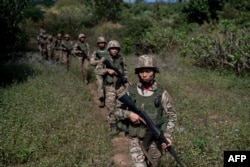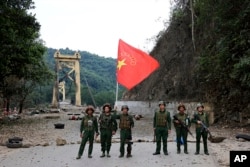February 1 will mark three years since Myanmar's military toppled the country's democratically elected government, setting off a bloody civil war that continues to tear apart the country of 54 million people.
It will also be just over three months since the launch of Operation 1027, a major offensive by some of the armed groups arrayed against the junta. The campaign has handed the military an unprecedented string of losses and redefined the war.
"When we talk about where we are today after three years, we're really talking about where we are today three months after 1027," Richard Horsey, a senior adviser on Myanmar to the International Crisis Group, told VOA.
Since the start of the offensive on October 27, opposition forces have seized several towns in northeast Myanmar's Shan state next to China, taken control of key roads to the border, and forced hundreds of junta soldiers to surrender.
The military has responded with punishing air and artillery strikes but so far failed to retake lost ground. That has emboldened other rebel groups across Myanmar to pounce, compounding the junta's losses.
"Across many different parts of the country, ethnic armed groups and resistance forces have gone on the offensive since the 27th of October," Horsey said. "It's people looking at the situation and saying, 'Wow, the Myanmar military has an awful lot on its hands right now and it's looking incredibly weak,' so it's giving confidence to these groups to go on the attack."
The International Institute for Strategic Studies, a British research group keeping track of the fighting, has recorded a rise in violence since June, with well over 1,000 events in both November and December.
Min Zaw Oo, an adjunct fellow at the nongovernmental Center for Strategic and International Studies in Washington, spent a month traveling across Myanmar late last year, speaking with junta battalion commanders and others.
He told VOA he found a military ill-prepared to reverse its losses after decades of mismanagement.
Down but not out
Min Zaw Oo said the military has failed for more than a generation to invest in the strategies and equipment needed to protect its fighters on the ground from attack. Fighting one or two rebel groups at a time, the military could muddle through in the past. Facing steady pressure on multiple fronts since the coup, though, has brought a fundamental flaw to the fore.
Under Gen. Min Aung Hlaing, who led the putsch, he added, the military has also been promoting more senior commanders with little to no practical battlefield experience.
Min Zaw Oo sees none of that changing any time soon, to the boon of the resistance.
"Under the current leadership, I think the military is not likely to make the fix to remedy their predicament," he said. "They're going to still ... fall short of strategic solutions."
All that is prompting predictions that resistance groups could actually prevail over one of the region's largest and most battle-hardened militaries, especially since the onset of Operation 1027. What once seemed like a long shot is now looking, to some, inevitable, even imminent.
Analysts, though, say prophesies of the junta's impending defeat or collapse are overblown.
"Given gains on the battlefield and the losses inflicted on the Sit-tat [military], there's a momentum that's building up that people can see — if we just keep going we can actually topple the military," David Mathieson, an independent Myanmar analyst, told VOA.
"But I do think that any kind of forecast of how imminent that's going to be has to be very conservative. People after 1027 were saying the military will fall in three to six months. You don't know that," he added.
Much of the ground the junta has lost since Operation 1027 started includes stretches of border with India, Bangladesh and, most critically, China, Myanmar's main trade partner. A key trade route with Thailand has also been coming under increased attack from resistance groups.
Mathieson, though, said the junta may plan to hang on even without controlling the borders by consolidating in the central plains around the largest cities, including Yangon and its seaport, and by holding the main military bases and weapons factories nearby along with the roads connecting them all.
Even with just that, he said, "They've still got the capacity to supply their military with the tools that they need to fight the war."
Divided we stand
While a steady stream of desertions and the recent surrender of whole battalions have sapped the military's strength, analysts also point out that junta soldiers have not been defecting and joining resistance groups en masse, suggesting that morale, even if down, has not crumbled.
The military is also fighting a deeply divided opponent. Despite the sophisticated coordination on show by the rebel armies behind Operation 1027, the country remains a patchwork of resistance groups without a single central command, many pursuing their own narrow goals.
"So, it's very difficult at this point to say what the resistance means," said Min Zaw Oo.
As the disparate factions scramble for territory, even some loosely allied groups have been tussling among themselves. Min Zaw Oo noted two rebel groups in the east that have started arguing over which of them gets to tax locals, and another two in the west among the ethnic minority Chin that recently clashed.
"That is the tip of the iceberg," he said, adding that, with time, "We will see a lot more problems coming up."
Analysts say resistance groups may find future gains against the junta increasingly tough as the military pulls back from weaker positions and concentrates on defending a few key areas. Min Zaw Oo said one bellwether for the future of the resistance will be whether groups in the east can manage to sever the highway connecting Yangon and Mandalay, Myanmar's two largest cities, both still firmly in the junta's grasp.
And as the junta continues to lose ground, they warn that it could turn even more violent, especially against civilians, as it has in the northeast in response to Operation 1027.
Of the 2.3 million people displaced by the fighting across Myanmar since the coup, the United Nations says, one-third have fled their homes in the past three months alone.
"The military might not have the ability to vanquish its opponents, but it retains an enormous capacity for violence, especially against civilian targets," said Horsey.
"It could get a lot, lot messier, and it could actually drag on for a long time," Mathieson agreed. Among his sources in Myanmar and its rebel armies, he added, "even the most optimistic ones don't think this is going to be over easily."
















